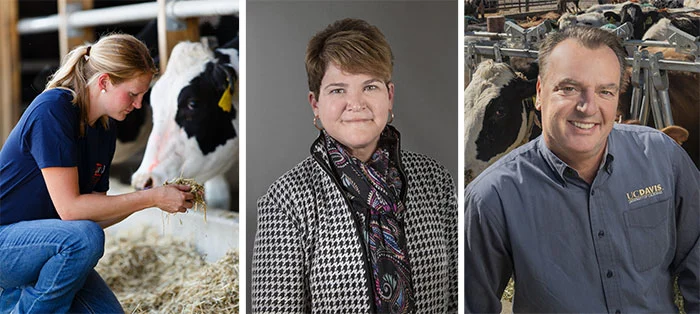Sustainable Farming Is a Longtime Commitment of U.S. Dairy Farmers
Every day, nearly 37,000 U.S. dairy farmers work with their cows and their land to produce some of the greenest nutrition the world knows: dairy.
Their goal is to help feed a growing global population that is expected to reach 9 billion by 2050 and do it in the most environmentally responsible way they can. This, however, is not a new priority for dairy farmers. It has been their legacy and remains a commitment to be passed on to the next generation.
Frank Mitloehner, PhD, a professor and air quality extension specialist in the Department of Animal Science at the University of California-Davis, has studied the progress and successes of U.S. dairy and uses a point in time to show just how far the industry has come. He looks all the way back to 1944.
The U.S. was home to 25 million dairy cows that year. Today, the herd size is around 9 million cows. But the dairy industry is doing much more with much less. Because of innovative practices related to cow comfort, improved feed and genetics, and modern barn design, dairy farmers are producing 60 percent more milk than when the herd was nearly three times as large.
Efficiencies aside, what sticks out to Mitloehner more is that research conducted in 2007 found the dairy industry accomplished this with 65% less water, 90% less land, a 63% smaller carbon footprint and 76% less manure than in 1944. An update of this research revealed more good news for dairy. Producing a gallon of milk in 2017 involved 30% less water, 21% less land, a 19% smaller carbon footprint and 20% less manure than it did in 2007.
“We have reduced the carbon footprint of a glass of milk by two-thirds over this period of time,” he said. “If you would have asked scientists 50 years ago, they would have told you there’s no way we can further improve efficiencies. Even 10 years ago, they would have told you the same thing. Guess what? They were all wrong. But one thing I can tell you is we will have further reductions of emissions and we will have further improvements in efficiencies. There’s no question about that.”
Further science shows how far the dairy industry as a whole has come. The industry completed a lifecycle assessment (LCA) of a gallon of milk in 2007 that established a grass-to-glass baseline. The research confirmed the industry contributes approximately 2% of total U.S. GHG emissions.
The LCA was groundbreaking and the first of its kind in terms of extensiveness and depth. It was the first agricultural LCA that included the whole value chain on a national level. The study also identified opportunities to further reduce GHG emissions and provide a benchmark for the industry to measure and report progress.
None of this comes as a surprise to U.S. dairy farmers. It’s long been said farmers are the original environmentalists as they make responsible use of their resources while protecting their land, not just for now but for future generations.
Optimistic Future
“Dairy farmers really are stewards of the environment because we’re working with our land and our animals to make sure we are going to be around for several more generations,” New York dairy farmer Abbey Copenhaver said. “My wonderful cows were green before going green was even cool.”
The dairy industry, however, is ready to take sustainable farming to a new place by focusing on its environmental footprint. Conversations have centered on how U.S. dairy can help feed the global population, while minimizing its GHG emissions and positively impacting soil health and air and water quality. Initial research shows that with the right economic support for new technologies and practices, some farms will be able to balance carbon emissions with carbon capture and step up waste reduction efforts to reach a net zero emissions status for the entire industry.
Krysta Harden, who previously worked for the U.S. Department of Agriculture, came to the dairy industry in April to help lead this effort. Harden serves as executive vice president of global environmental strategy for Dairy Management Inc. (DMI), which represents U.S. dairy farmers. DMI’s mission is to build dairy demand and grow consumer confidence in the industry.
Since joining DMI, Harden has spent time visiting with dairy farmers across the country to learn from them about what they are doing and ideas they have to further reduce their environmental impact.
“Dairy farmers have long been, since the beginning of dairy and the milking of cows, great stewards,” Harden said. “They appreciate their cows, they appreciate their natural resources and care greatly for them. They have a great reputation for really taking great care of nature and the resources that go into dairy farming.”
Harden said it is second nature for dairy farmers to do the right thing when it comes to minimizing their impact and that there is excitement about the possibilities. But farmers understand these sorts of efforts matter more today than ever before to consumers, who are now making purchasing decisions based on social and environmental impact; they want to know that what they are purchasing is good for them and good for the planet. Harden sees this as a great opportunity to connect consumers to the farm.
“Ultimately, we’ve got to think about our end user, the folks who are going to purchase our product,” she said. “I think there’s an opportunity to continue to have the dialogue with consumers to be open, to talk to them about these processes and what actually it entails.
“I am extremely optimistic. I know that dairy farmers are committed to stewardship. They lead with that in everything they do. They know this is a challenge, but they’re also confident that we can accomplish something here.”
















